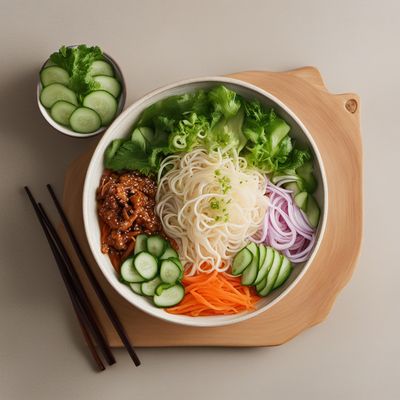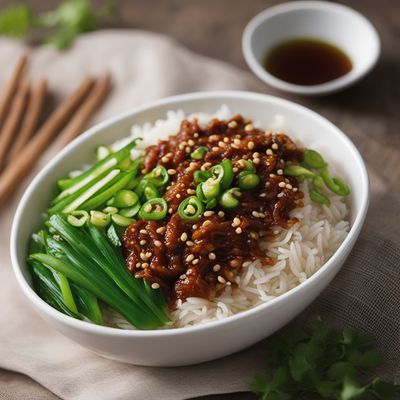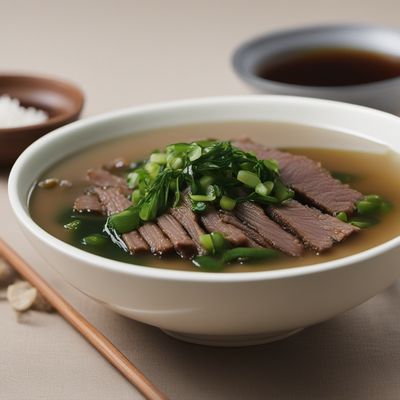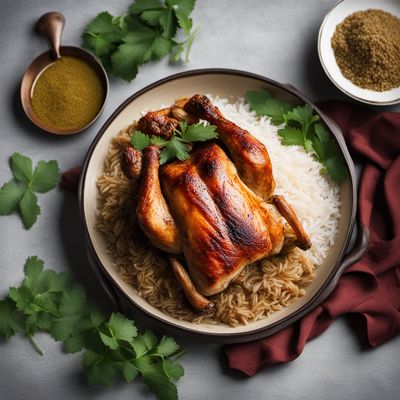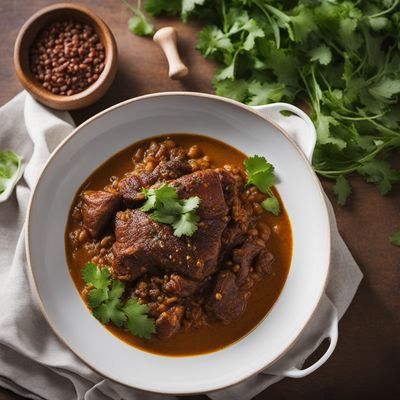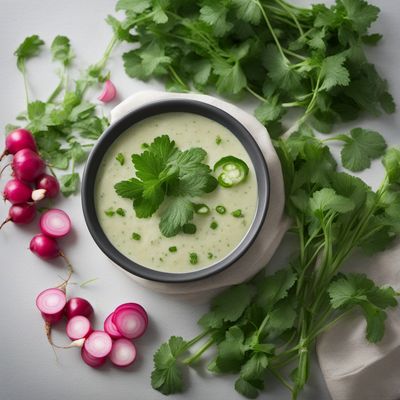
Recipe
Yemeni-style Jaengban Guksu
Spiced Noodle Salad with Yemeni Flavors
4.5 out of 5
This recipe is a Yemeni twist on the traditional Korean dish, Jaengban Guksu. It combines the vibrant flavors of Yemeni cuisine with the refreshing elements of a noodle salad, resulting in a unique and delicious fusion dish.
Metadata
Preparation time
20 minutes
Cooking time
10 minutes
Total time
30 minutes
Yields
4 servings
Preparation difficulty
Easy
Suitable for
Vegetarian, Vegan, Dairy-free, Gluten-free (if using gluten-free noodles), Nut-free
Allergens
Wheat (if using wheat noodles)
Not suitable for
Paleo, Keto, Low-carb, High-protein, High-fat
Ingredients
In this Yemeni adaptation of Jaengban Guksu, we incorporate Yemeni spices such as cumin, coriander, and turmeric to infuse the dish with warm and aromatic flavors. The dressing is also modified to include lemon juice and garlic, adding a tangy and zesty element to the salad. We alse have the original recipe for Jaengban guksu, so you can check it out.
-
250 grams (8.8 oz) thin wheat noodles 250 grams (8.8 oz) thin wheat noodles
-
1 cucumber, julienned 1 cucumber, julienned
-
1 carrot, julienned 1 carrot, julienned
-
1 red bell pepper, thinly sliced 1 red bell pepper, thinly sliced
-
1 green bell pepper, thinly sliced 1 green bell pepper, thinly sliced
-
1 small red onion, thinly sliced 1 small red onion, thinly sliced
-
2 tablespoons fresh cilantro, chopped 2 tablespoons fresh cilantro, chopped
-
2 tablespoons fresh parsley, chopped 2 tablespoons fresh parsley, chopped
-
1 teaspoon ground cumin 1 teaspoon ground cumin
-
1 teaspoon ground coriander 1 teaspoon ground coriander
-
1/2 teaspoon ground turmeric 1/2 teaspoon ground turmeric
-
Juice of 1 lemon Juice of 1 lemon
-
3 tablespoons olive oil 3 tablespoons olive oil
-
2 cloves garlic, minced 2 cloves garlic, minced
-
Salt and pepper to taste Salt and pepper to taste
Nutrition
- Calories (kcal / KJ): 280 kcal / 1172 KJ
- Fat (total, saturated): 10g, 1.5g
- Carbohydrates (total, sugars): 40g, 5g
- Protein: 6g
- Fiber: 4g
- Salt: 0.5g
Preparation
-
1.Cook the noodles according to package instructions. Drain and rinse with cold water to cool them down.
-
2.In a large mixing bowl, combine the cooked noodles, cucumber, carrot, red bell pepper, green bell pepper, red onion, cilantro, and parsley.
-
3.In a small bowl, whisk together the ground cumin, ground coriander, ground turmeric, lemon juice, olive oil, minced garlic, salt, and pepper.
-
4.Pour the dressing over the noodle mixture and toss well to combine.
-
5.Allow the salad to sit for at least 15 minutes to allow the flavors to meld together.
-
6.Serve the Yemeni-style Jaengban Guksu chilled and enjoy!
Treat your ingredients with care...
- Noodles — Be sure not to overcook the noodles as they should be slightly chewy. Rinse them with cold water after cooking to stop the cooking process and cool them down quickly.
Tips & Tricks
- For added protein, you can top the salad with grilled chicken or shrimp.
- Feel free to adjust the spice levels according to your preference by adding more or less of the Yemeni spices.
- If you prefer a spicier salad, you can add a pinch of cayenne pepper or chili flakes to the dressing.
- This salad can be made ahead of time and stored in the refrigerator for up to 24 hours. Just give it a good toss before serving.
Serving advice
Yemeni-style Jaengban Guksu is best served chilled. Garnish with additional fresh herbs and a squeeze of lemon juice for an extra burst of flavor.
Presentation advice
Serve the salad on a large platter or individual plates, arranging the colorful vegetables and noodles in an appealing and appetizing way. The vibrant colors and fresh ingredients will make the dish visually appealing.
More recipes...
More Korean cuisine dishes » Browse all
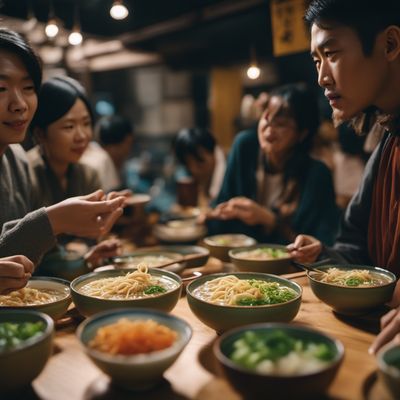
Kalguksu
Hand-cut Noodle Soup
Kalguksu is a Korean noodle dish made with handmade noodles and a variety of vegetables and meats. The dish is usually served in a hot soup.

Gamjasaelleodeu
Potato salad
Gamjasaelleodeu is a Korean dish made with potatoes and beef.
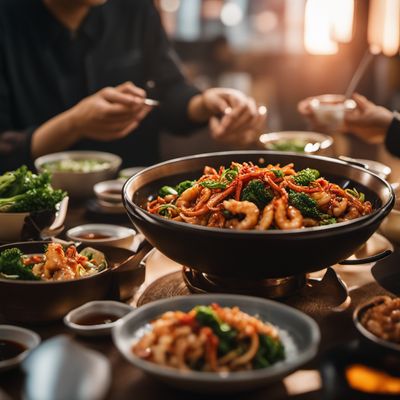
Ojingeo chae bokkeum
Spicy Squid Stir-Fry
Ojingeo chae bokkeum is a Korean stir-fry dish that is made with squid and vegetables. It is a popular dish in Korean cuisine.
More Yemeni cuisine dishes » Browse all

Galayet bandora
Tomato and onion stew
Galayet bandora is a Palestinian dish made with tomatoes and onions. It is a simple and flavorful dish that is often served for breakfast.

Mathrooba
Mathrooba is a traditional Yemeni dish made with bread, meat, and spices. It is a hearty and flavorful meal that is perfect for cold winter nights.
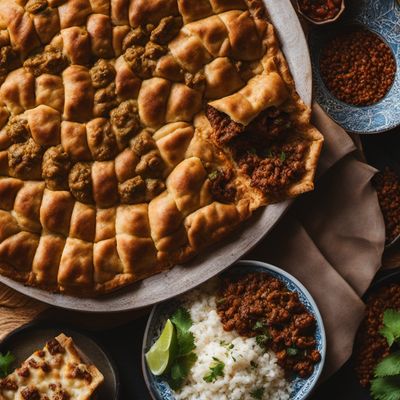
Masroshi
Masroshi is a traditional Yemeni dish made with spiced ground beef and a crispy, flaky pastry. This savory snack is perfect for a quick lunch or...
